You’ve made an alcohol-based tincture with cannabis or herbs. Now you’re ready to evaporate the alcohol to remove the burn, concentrate the volume, or make FECO – but you’ve heard it can be potentially dangerous. Have no fear! This guide will review all the different ways to evaporate alcohol from cannabis tinctures safely and effectively.
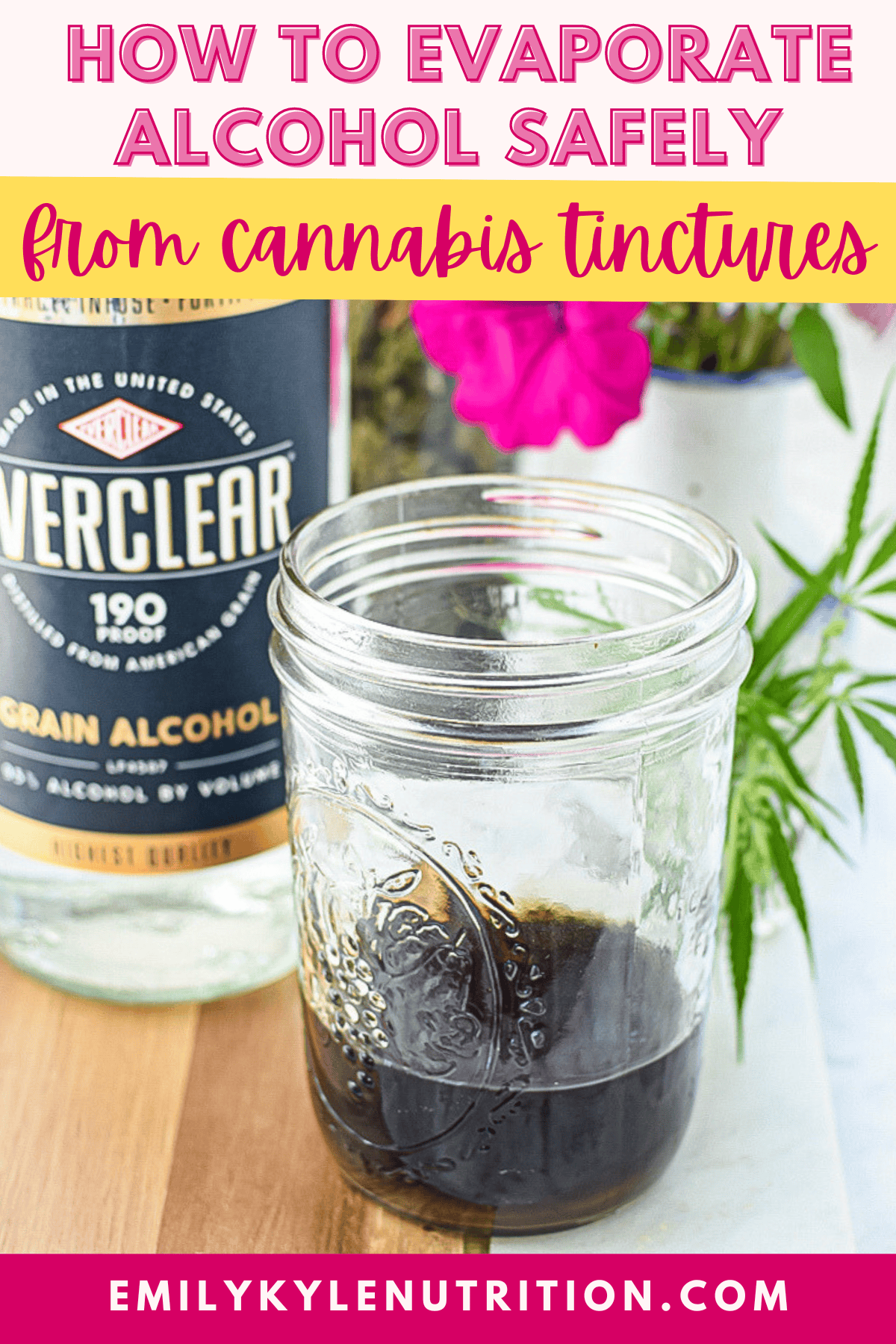
Table of Contents
- Article Features
- Why You Will Love This Guide
- Why Evaporate The Alcohol?
- Safety Considerations
- Safe Evaporation Options
- Invest in the Source Turbo
- Unmatched Efficiency and Performance
- Easy to Use for All Skill Levels
- Compact Design and Quiet Operation
- Perfect for Everyone
- The Ultimate Investment
- What You’ll Need
- Step-by-Step Instructions
- Storage Instructions
- How to Evaporate Alcohol From Tinctures Recipe
- Frequently Asked Questions
- Recipes To You Make With Your Tincture
Article Features
- Safety considerations for evaporating alcohol
- No-heat and low-heat options
- Want to make it easy? Skip the hard work, order high-quality cannabis products from my shop, and have them delivered straight to your door – now shipping across the United States!

Why You Will Love This Guide
Let me guess. You’ve made – or want to make – an alcohol-based tincture like the Green Dragon or Golden Dragon with cannabis or other herbs.
You’ve heard that they’re a great way to medicate and reap the benefits of the plant.
But you’re currently stuck with – or worried about – the unpleasant, burning alcohol mixture that doesn’t taste or feel good.
So, what can you do to fix the problem? Evaporate the alcohol.
But how…especially when the process can be potentially dangerous?
Don’t worry. In this guide, I will teach you how to evaporate alcohol safely so you can eliminate the burn, concentrate your tincture for use in recipes, and easily make FECO, or full-extract cannabis oil.
Why Evaporate The Alcohol?
If you’ve used any of my tincture recipes, you’ve likely used high-proof alcohol.
The high-proof alcohol used during extraction is, no doubt, harsh and unpleasant. You know the burning sensation if you’ve ever put a drop under your tongue.
But using high-proof alcohol is a necessary evil.
It’s a powerful solvent that helps extract the cannabinoids we want, like CBD and THC, and separate them from the plant matter we don’t want.
The good news is that you can reduce or completely eliminate the alcohol from a tincture through evaporation, leaving behind all the good stuff.
This makes it easier for you to enjoy all of the benefits a tincture offers without discomfort.
Evaporation can happen naturally at room temperature or speed up the process by introducing heat.
Heat evaporates the alcohol faster, along with air movement, such as with a fan.
Remember, evaporation can only happen when the tincture is exposed to air. It will not evaporate if your tincture is covered with a lid, such as in a mason jar.
There are many ways to introduce heat to evaporate the alcohol from a tincture, some of which are safer than others. Let’s review them below.
Safety Considerations
First, let’s ensure we are safely evaporating the alcohol in a way that does not cause physical harm.
Here are the most important safety considerations to remember before starting.
Skin Contact
Strong alcohol may cause skin irritation when there is direct contact.
Always wear protective gloves when handling alcohol to minimize the risk of irritating your hands.
Removing and washing all contaminated clothing thoroughly after handling it is also good.
Eye Contact
Avoid splashing alcohol on or near your face, as it can harm your eyes.
If you accidentally get alcohol in your eyes, clean the eyes with water or regular saline.
If symptoms do not disappear after twenty minutes of washing, seek medical help.
Inhalation
It is recommended to evaporate the alcohol in an open place or a well-ventilated room.
Do not allow the vapor to come directly into your nose.
If you feel you have inhaled the alcohol vapor, move to an open place with good air circulation.
Safe Evaporation Options
The main risk during the evaporation of alcohol is starting a fire or an explosion.
That means if you have a gas stove, you should not use it to evaporate the alcohol.
There are many safe alternatives that involve the use of no heat or indirect heat.
Warning:
High-proof alcohol is highly flammable and should not be exposed to open flames. Exposing alcohol to open flames may start a fire or cause an explosion. When evaporating alcohol, take similar precautions when handling gasoline or other flammable liquids and avoid open flames.
No Heat Method
You can evaporate alcohol just by letting a tincture sit uncovered at room temperature, but that can take a very long time.
Below is a picture of a shot glass I filled with 1 ounce of the tincture. It took approximately 3-4 days for the alcohol to evaporate.
This timing will depend on how much liquid is in the glass and the temperature settings where you are.
If you’re patient, this no-heat evaporation process works just fine.
I recommend adding a coffee filter or other breathable material to the top of the container when air drying to keep any contaminants from getting in.
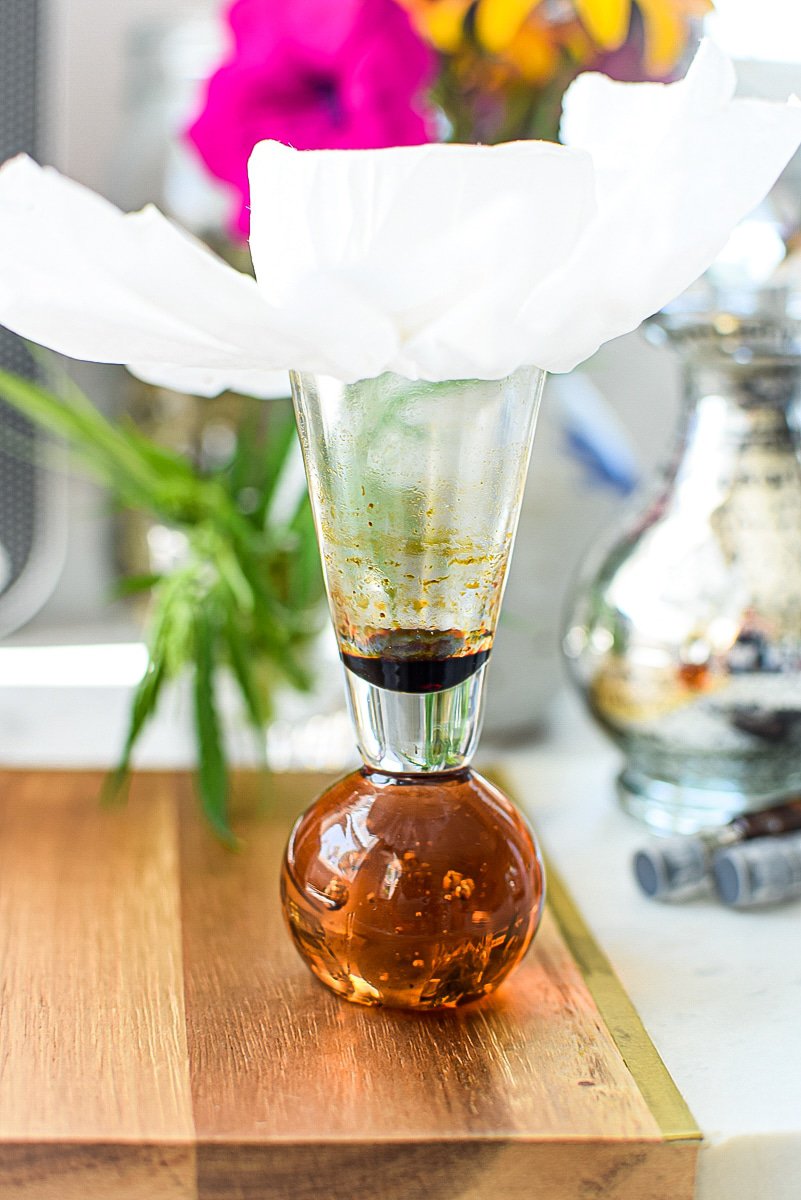
Indirect Heat Methods
We can safely speed up the evaporation process by introducing low heat without the use of flames.
Indirect heat is one of the safest, most popular methods to introduce heat for evaporation.
There are many simple ways to do this.
SAVE THIS GUIDE 💌
Here are ways my Well With Cannabis Community members have successfully used as indirect heat sources:
- A mini-crockpot
- Water bath in a crockpot
- Heating pad
- Coffee mug warmer
- Candle warmer
- Instant Pot
- Rice cooker
When introducing indirect heat, I suggest first placing the tincture in a glass mason jar.
This will collect the important concentrated tincture, or FECO left at the end of the process.
Below, I will give you a step-by-step of how I use a mini-crockpot to evaporate the alcohol from a tincture safely.
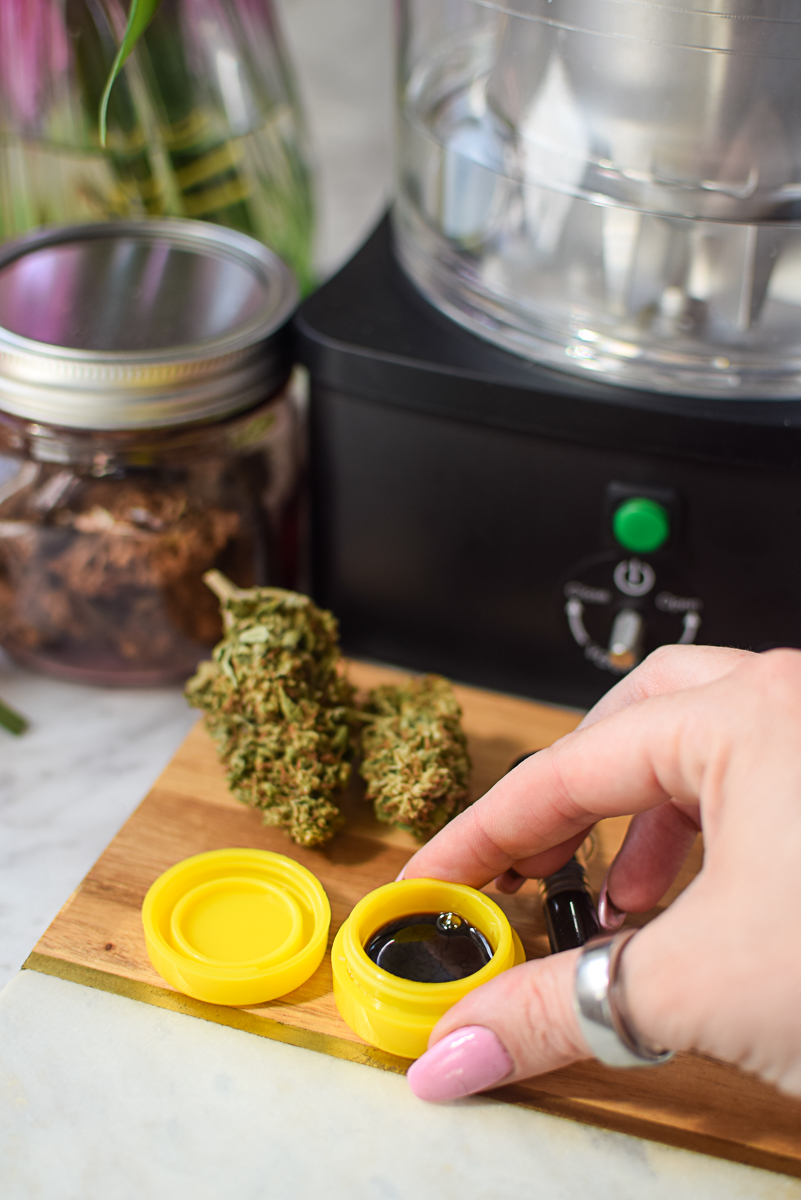
Invest in the Source Turbo
If you’re looking for a reliable, efficient, and user-friendly way to evaporate alcohol from tinctures, the Source Turbo stands out as the ultimate solution.
Whether you’re a beginner or an experienced enthusiast, this innovative machine combines advanced technology with thoughtful design to ensure consistent, high-quality results every time.
Unmatched Efficiency and Performance
One of the standout features of the Source Turbo is its impressive efficiency.
This machine is designed to recover up to 95% of the alcohol used in your tincture, reducing waste and saving you money in the long run.
Its state-of-the-art vacuum distillation system works at low temperatures, minimizing the risk of degrading delicate compounds in your tinctures.
This means you can preserve the purity and potency of your extracts while speeding up the evaporation process compared to traditional methods.
Easy to Use for All Skill Levels
Whether you’re just starting or have been crafting tinctures for years, the Source Turbo is surprisingly simple to use.
Its intuitive controls and straightforward setup take the guesswork out of the process, making it accessible to anyone.
The companion app further enhances the experience, allowing you to monitor and control the machine directly from your smartphone. With step-by-step guidance and real-time updates, it’s like having an expert by your side.
Compact Design and Quiet Operation
Unlike bulky or noisy alternatives, the Source Turbo boasts a sleek, compact design that fits easily into any workspace. It’s lightweight and portable, making it ideal for home use.
Plus, its whisper-quiet operation ensures you can run the machine without disturbing your household or neighbors. This combination of convenience and discretion makes it a game-changer for anyone looking to refine their tincture-making process.
Perfect for Everyone
The versatility of the Source Turbo caters to a wide range of users.
Beginners will appreciate its simplicity, while seasoned creators can rely on its precision and consistency to elevate their results.
With this machine, you can enjoy professional-grade performance right in the comfort of your own home, no matter your level of experience.
The Ultimate Investment
The Source Turbo isn’t just a piece of equipment—it’s a long-term investment in the quality of your tinctures. With its ability to preserve potency, recover alcohol efficiently, and simplify the evaporation process, this machine pays for itself over time.
Take the Next Step: If you’ve been searching for the best way to evaporate alcohol from tinctures, look no further. Make the Source Turbo a part of your setup today and experience the difference it can make!
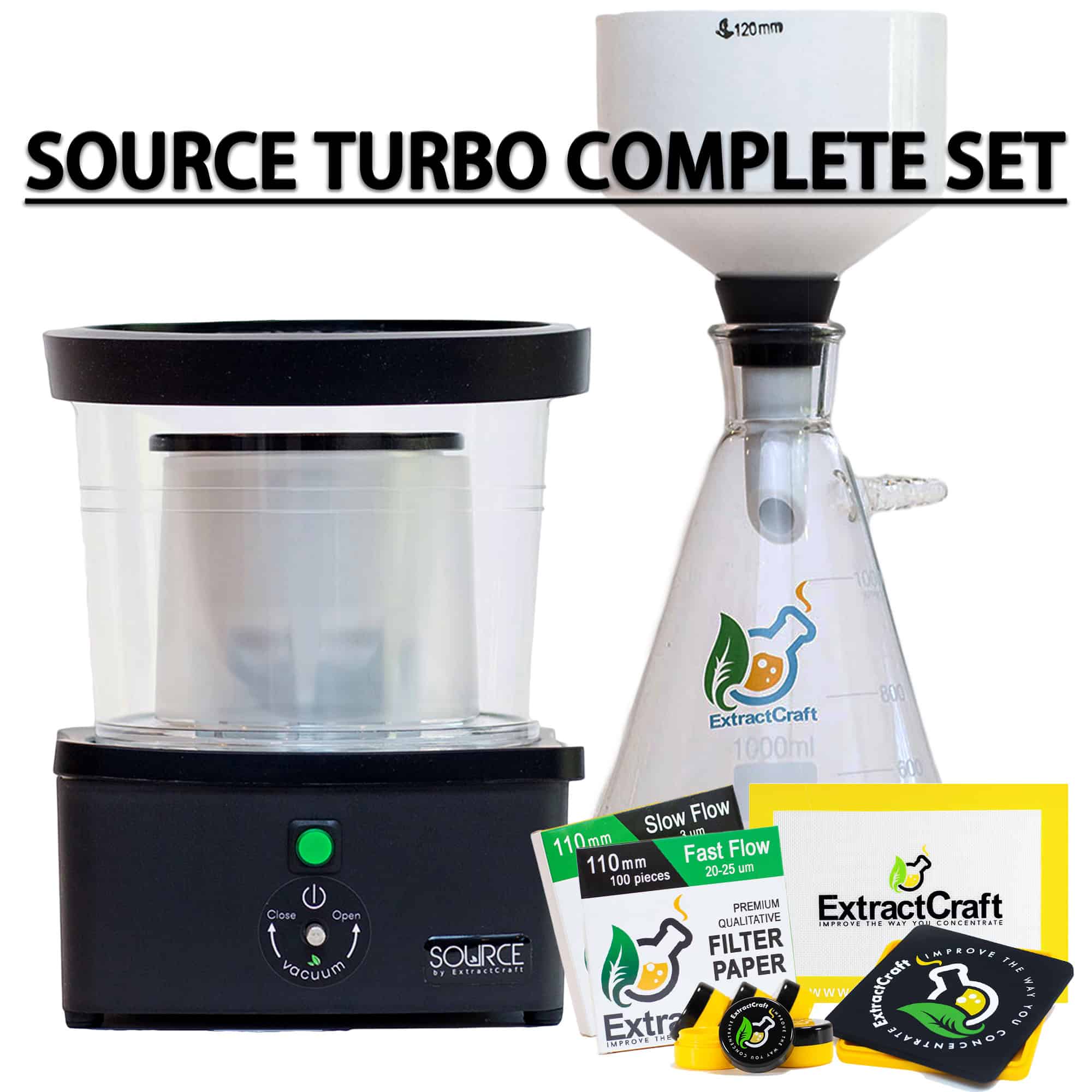
What You’ll Need
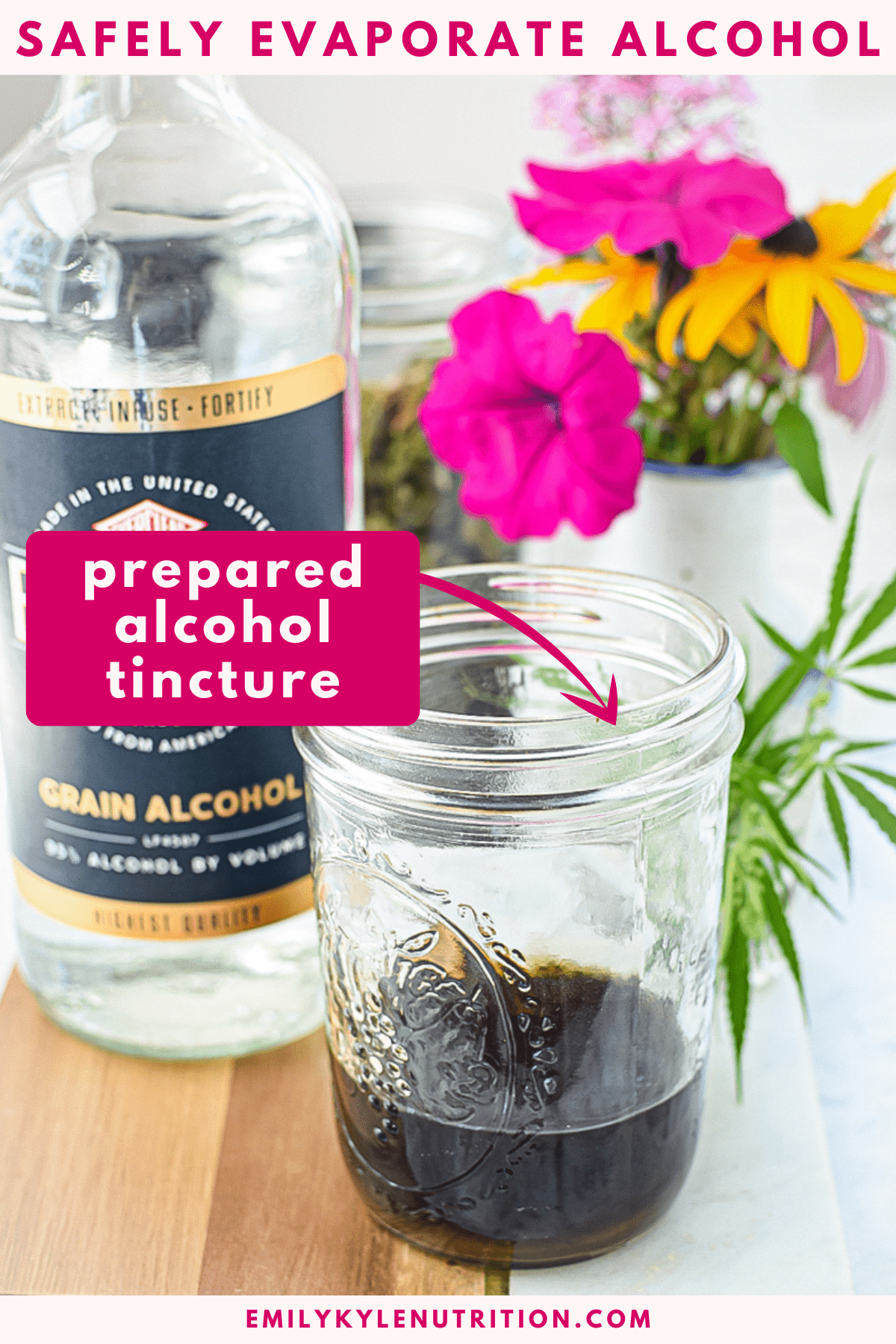
Note: This process will not work with oil-based tinctures like MCT oil. It MUST be an alcohol-based tincture.
- Alcohol-Based Cannabis Tincture Recipes:
Note: a complete list of ingredients with amounts and printable instructions is located in the recipe card below.
Step-by-Step Instructions
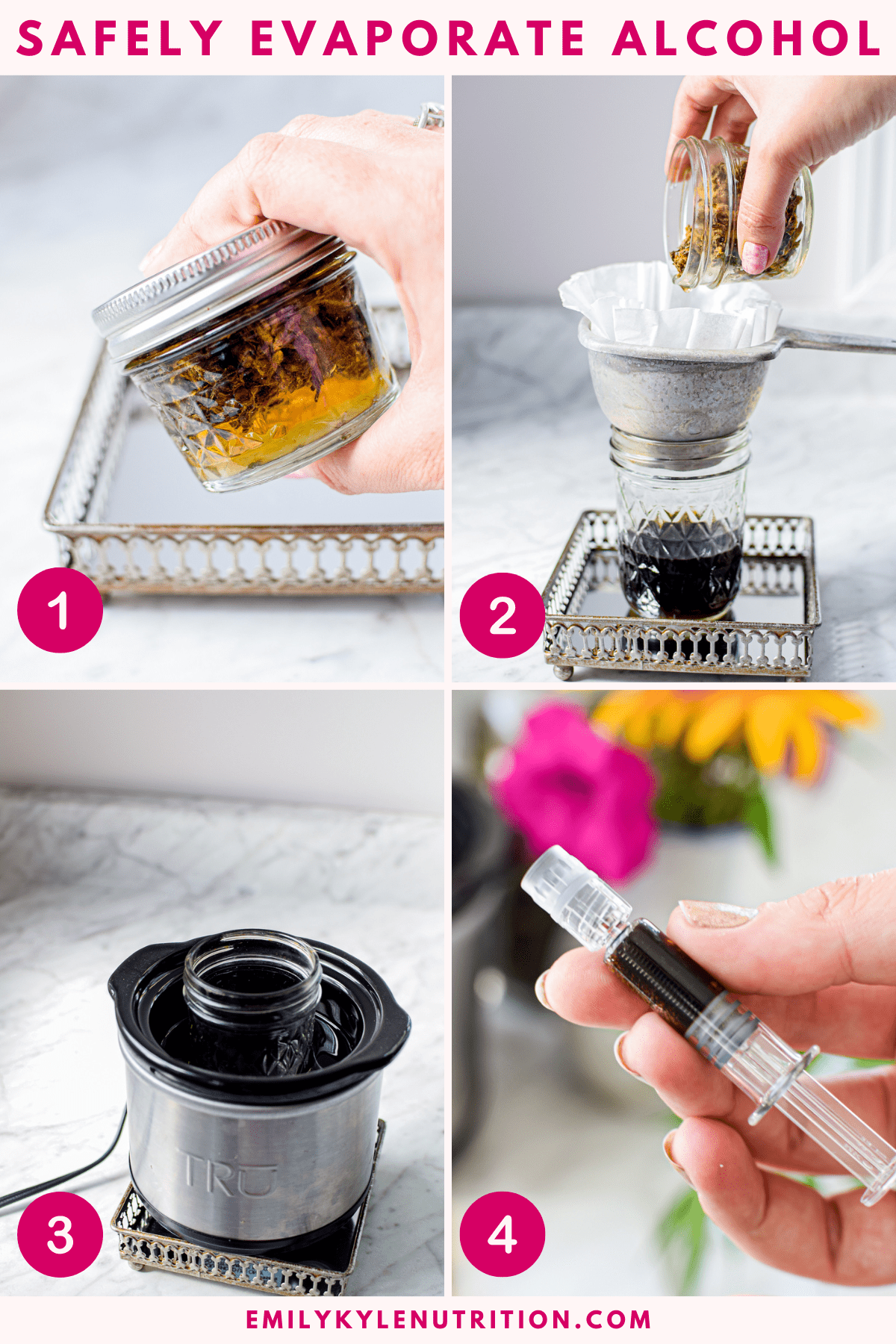
- Step 1 – If you haven’t already, prepare an alcohol-based tincture. Options include the Green Dragon, Golden Dragon, THCA tincture, CBDA tincture, or cannabis root tincture.
- Step 2 – Do not forget to strain the tincture; this is very important.
- Step 3 – Place the tincture in a mason jar that fits in the mini-crockpot. Carefully pour water into the crockpot, but around the jar, creating a water bath. Turn the mini-crock pot on warm and allow the water to heat up.
- Step 4 – Let the tincture sit in the water bath and wait. The warmth of the water bath will cause the alcohol to begin evaporating into the air. How long this will take will depend on the volume you start with.
- Note: You do not need to evaporate off all of the alcohol if you do not want to. By reducing just half of the alcohol, you will effectively double the potency of your tincture. How much you choose to evaporate, all comes down to personal preference.
Note: complete step-by-step printable instructions are located in the recipe card below.
Storage Instructions
Store your FECO in a glass syringe, capsule, or airtight glass container. Store in a cool, dark place like a medicine cabinet.
FECO can be stored in the refrigerator for longer-term storage and in the freezer for even more long-term storage (6+ months).
Learn more about how to store edibles here.
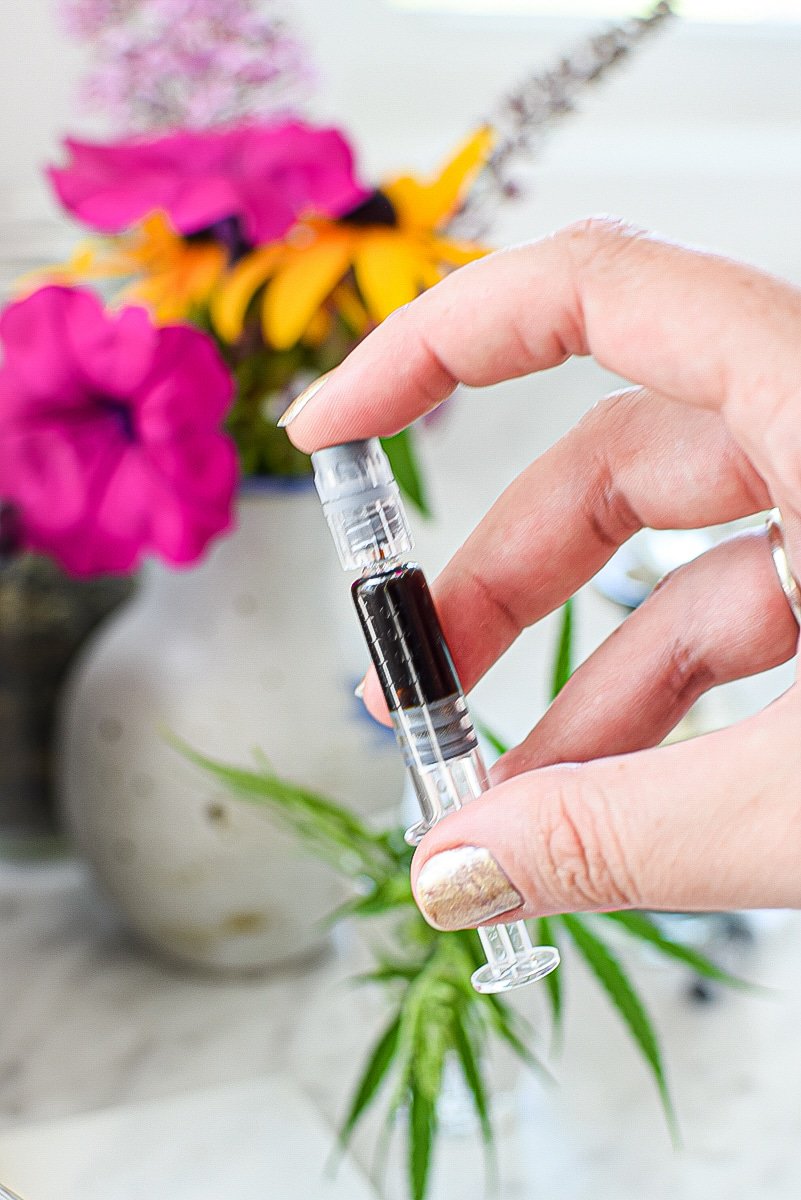

How to Evaporate Alcohol From Tinctures
Equipment
What You Need
- 8 ounces cannabis tincture *Any volume you desire
- 1 cup water
Instructions
- For your safety, I recommend you set this up this in a room with good ventilation, keep the windows open, with good moving airflow.
- Place your alcohol-based tincture into a mason jar that will comfortably fit in the mini-crockpot. Place the jar on the bottom of the crock pot.
- Carefully pour water around the jar and into the crockpot, creating a water bath. You do not need to use all of the water. Use enough to cover the contents in the jar, but not overflow.
- Turn the mini-crock pot on warm and allow the water bath to heat up. Be sure you do not have a lid on the jar, as this will slow or prevent the evaporation process.
- The time it takes to evaporate the alcohol will depend on the starting volume, or how much tincture you have.
- If you are working with non-cannabis herbs, you can evaporate 10-90% of the alcohol in your tincture. How much you evaporate will determine how strong your end product is. The more alcohol that evaporates away, the more concentrated the tincture becomes.
- If you are working with cannabis, the goal to make FECO is to reduce 95-100% of the alcohol. How long this takes will depend on the volume. For example, 1 cup of tincture will take approximately 4-5 hours to evaporate into FECO. More volume will mean more time, and less volume will mean less time.
- The alcohol will evaporate during the heating process, reducing the volume and leaving behind a thick, black, sticky substance. This black oil is your medicine, or FECO.
- If this black oil gets too sticky or hard to work with, add a few drops of alcohol or carrier oil to the jar and mix well to create a more viscous oil.
- Store your FECO in a glass syringe, capsule, or another airtight glass container. Store in a cool, dark place like a medicine cabinet.
Notes
Frequently Asked Questions
The length of time required to evaporate alcohol depends on many factors, including volume, temperature, and airflow. For example, 1 cup of tincture took approximately 4-5 hours to evaporate into FECO. More volume will take longer, and less will be shorter.
Check out this guide here, where you can discover how to order high-proof grain alcohol online and have it shipped to your door or learn more about what to ask for when visiting your local liquor store.
These are just two different tincture-making methods. The Green dragon involves a long soak of 24 hours or more, and the Golden dragon involves the freezer and a short soak of a few minutes. You can learn more about the potency differences in these methods here.
If you started with an alcohol-based tincture, yes. The alcohol will evaporate during the cooking process, reducing the volume and leaving behind a thick, black, sticky substance. This black oil is FECO or your medicine.
Actually, yes! The easiest way I’ve found to evaporate the alcohol naturally is to place the tincture on something and allow the alcohol to evaporate off naturally, like with these store-bought gummies. Or you could follow this recipe for gummies made with tincture.
If you have questions or are looking for guidance on your journey, I definitely recommend joining the Well With Cannabis Community, where you can ask questions and get support.
Recipes To You Make With Your Tincture
Articles & How-To Guides
How to Use A Cannabis Tincture: Step-by-Step Guide
Cannabis Infusions & Extractions
How to Make Full-Extract Cannabis Oil (FECO)
Cannabis Dessert Recipes
How to Make Cannabis Sugar – Quick & Easy Guide
Cannabis Drink Recipes
Easy Cannabis-Infused Red Wine Sangria



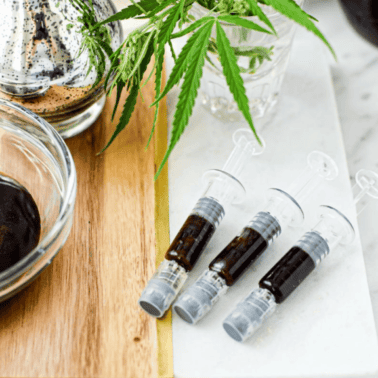
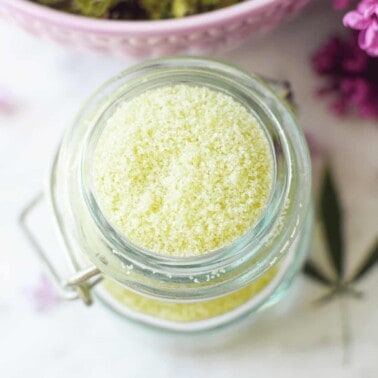

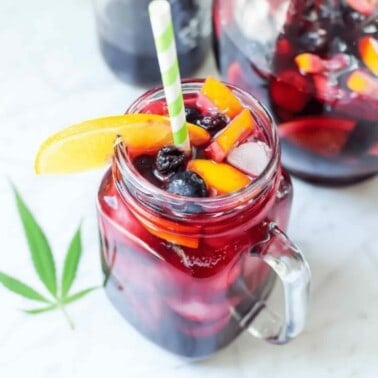
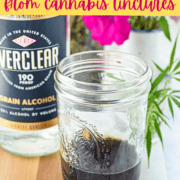








Thank you for all your great information!
Piggybacking off Rick’s question I wondered if there are some herbal tinctures that would lose the potency by reducing the tincture.
Also do you have an article or insight about how to know the level of potency while making tinctures (reducing to add glycerine or just keeping alcohol only)?
Thanks again!
Peace and blessings,
Tina
Hello Tina, thank you so much for your thoughtful question. When it comes to herbal tinctures, some can indeed lose potency when reduced, especially if the active components of the herb are sensitive to heat or prolonged exposure to air during the process. Herbs with volatile oils, like peppermint or lavender, are a good example of this, as their beneficial properties might evaporate or break down when heated.
As far as measuring potency, it can definitely be a bit tricky while making tinctures, especially when incorporating glycerine versus alcohol. Alcohol is often preferred for its ability to extract and preserve a wider range of active compounds. Glycerine can work as a milder, non-alcoholic alternative, but it may not extract certain constituents with the same efficacy. To gauge potency, keeping notes on the herb-to-solvent ratio and steeping times can really help.Thank you again for reaching out with such a great question!
can o reduce my ticture down to a thick cosistancy. And add a little food grade vegetable glycol to it so it is easier to put into capsules? For help fighting cabcer. And thanks for all your great recipes and help.
Thank you so much for reaching out and for your kind words about the recipes, Rick, it makes me so happy to hear they’re helpful to you! You can absolutely reduce your tincture down to a thicker consistency by gently evaporating off some of the alcohol. Once it’s thicker, it’s fine to add a small amount of food-grade vegetable glycerin to make it easier to handle and fill into capsules. Just remember to mix thoroughly so it’s consistent. I truly wish you the best in your fight against cancer, and I’m always here if you need anything!
We made tincture by adding 1 oz of cannabis to 10 oz of alcohol and put in freezee shaking it up every few days. After a month we took it out and strained it and placed in a mason jar with lid on. Do I evaporate this before making your gummy recipe? I am new to this. We have had this strained product for months….does it lose strength and if so how fast?
Thank you for reaching out and sharing your process, Bee! It sounds like you’ve done a great job so far. For my gummy recipe, you will need to evaporate some of the alcohol to concentrate the tincture before use. When it comes to potency, as long as your tincture has been stored in a cool, dark place with the lid tightly sealed, it should still be effective. Over time, though, tinctures may slowly lose potency, but it typically takes quite a while. I’m so happy you’re exploring this—I’m here to help if you have more questions! 😊
Eek!!! I tried to make golden dragon. About 24 grams flower and at least a pint of everclear. I put it in a large bowl, no lid, thinking I was evaporating the alcohol taste off. I woke up yo an empty bowl with some white liquid. Not even 2 tablespoons of gunk. Where on earth did I mess up!!!
Hi Linda. It looks like water has possibly gotten in with your tincture. Most of the alcohol has evaporated, leaving behind Full-Extract Cannabis Oil (FECO) and likely, excess moisture that can still be evaporated. Feel free to add back in alcohol or carrier oil to thin out the highly concentrated cannabis oil. You didn’t mess anything up 🙂
This is amazing! I’m surprised that there isn’t much more info “out there” about evaporating the alcohol from tinctures.
I’m not using cannabis yet, so currently working with elderberry, yarrow, clever, and chamomile.
I’m wondering about the potency…so if I started with a 1:1 ratio of herb to alcohol (used everclear), then would the potency of my tincture after straining be 100%?
Then, if I evaporate about 90% of the alcohol…I have less liquid but the potency is higher?
So if added the glycerin am o diluting it the same as if I didn’t evaporate the alcohol?
Geez, I can’t ask properly and I’m hoping you can catch my drift enough for a little guidance.
Thanks for all you do though!!! ☮️
Hello Tina, thanks so much for reaching out with your thoughtful question—this is such an interesting topic! You’re absolutely on the right track when it comes to understanding how the potency of your tincture changes with adjustments to the liquid. If you begin with a 1:1 ratio of herb to alcohol and then strain it, your potency is essentially determined; however, when you evaporate 90% of the alcohol, you are indeed left with less liquid, meaning that what remains is more concentrated. Adding glycerin after evaporation would dilute your tincture somewhat, but the final potency would depend on the exact ratio of glycerin to the concentrated tincture. It’s a bit like balancing flavors in a recipe—small adjustments can lead to different outcomes, but it’s all an experiment! I hope this helps clarify things a bit, and please feel free to follow up if you have more thoughts or questions.
I made this and it worked well, but still has the strong alcohol burn
I evaporated about 80-85% of the alcohol. What did I do wrong?
Thank you for reaching out, Rolf! It sounds like you’re on the right track. Since you still have about 20-15% alcohol left, it’s normal for there to be a bit of a burn. To fix this, I recommend continuing to evaporate until there’s less than 5% alcohol remaining. This should help with the strong alcohol burn. 😊
This is the best website I have found and very great at explaining the details… One thing I would like to ask. What ratio of decarb shatter concentrate would you recommend using to the high proof alcohol? I seen elsewhere a 10:1 ratio. Also I do plan on making store bought gummies with my tincture. So if I make my tincture, and then still reduce it slightly. Would that still increase potency before adding drops to my gummies? I found my first try it would only soak up so much of the tincture and it just wasn’t quite there to be strong from one gummy. Thank you!
Thanks for the kind words, Graeme! For a tincture, a 10:1 ratio of alcohol to decarbed shatter is a good starting point. But if you’re planning on reducing the tincture to increase potency, then you should start with less alcohol to save time. No need to evaporate. Keep experimenting to find the perfect balance — sounds like you’re on the right track!
So how would you do this in the instant pot? Just put it in the pot, add water and run it on the slow cooker cycle?
Doesn’t the IP have to have the lid on for the slow cooker cycle to run?
Hi Stu. You can absolutely use an Instant Pot for this by running it on the slow cooker setting. There should be no issue in keeping the lid off to allow the alcohol to evaporate properly. Just be sure to work in a well-ventilated area and keep an eye on the process for safety. I hope this helps!
Hello Emily. You always share very good advice. My question is, what are ways of ingesting FECO other than gummies and tea its so thick.
Hi Lance. FECO’s thick texture can be a bit tricky, but there are plenty of options. You can place a small amount directly under your tongue, mix it into sauces or soups, or even add it to capsules for easy ingestion. Whatever works best for you!
How do I know when 95% has evaporated?
Great question, Bob. You’ll know most of the alcohol has evaporated when the liquid thickens and its strong alcohol smell fades significantly.
want to make under-the-tongue tincture using ABV, need to know best thing for getting rid of the alcohol burn of the everclear. Can I evaporate all the alcohol and remix with something else? Or should I evaporate only half and remix? And what is the best carrier for under-the-tongue usage?
Hi Lori. You can evaporate some or all of the alcohol and replace it with a milder carrier like MCT oil or vegetable glycerin, both great for under-the-tongue use. Just be sure to heat gently to preserve potency!
How do I know how much alcohol is evaporated in my mini crockpot? Thanks
Hi Edward! The amount of alcohol that evaporates in your mini crockpot will depend on factors like temperature, cooking time, and whether the lid is on or off. Using a low heat setting and leaving the lid off can help the alcohol evaporate slowly. However, it’s difficult to determine exactly how much alcohol is left without actually taking out to measure. Hope that helps!
I evaporated all the alcohol out of my tincture on a teflon liner. Now I’m left with a ball of sticky dark brown tar. When making gummy’s do you think this will melt or dissolve into the gummy mixture or should I try to dissolve it in a little alcohol first? I don’t have anymore food grade ethanol so I’ll probably try to dissolve it in some vodka if I have to. My last gummy batch I didn’t evaporate it and they kind of have an alcohol aftertaste.
Hi Matt. You can try dissolving the sticky tar in a small amount of vodka before adding it to the gummy mixture. This should help it blend more smoothly and avoid clumping. Just make sure to use as little vodka as possible to avoid altering the texture of the gummies. The alcohol should mostly evaporate out as you cook the gummy mixture. Good luck!
Thank you,your advice has been so helpful!!
Glad you found it helpful — thank you for reading!
What seeing would I use on the instapot? To burn the alcohol?
To burn off the alcohol in an Instant Pot, you can use the “Sauté” setting. Let the liquid simmer uncovered for a few minutes to allow the alcohol to evaporate. Just be sure to stir occasionally and keep an eye on it to prevent burning!
You mention that you can remove up 90% of the alcohol in a herbal tincture with this method buy up to 100% of the alcohol with a cannabis tincture. Why does a non cannabis herbal tincture retain 10% alcohol?
Great question, Natalie! The reason a non-cannabis herbal tincture retains about 10% of the alcohol, even after using the removal method, often comes down to the solubility of the herbal compounds. Some components in the herbs may bind with the alcohol, making it more challenging to remove completely. Thanks for bringing this up!
After the evaporation of 50 percent of the alcohol.
Should it be topped off with honey or something else?
Will that weaken the tincture?
I use tincture to make gummy bears.
Just don’t what to do after evaporation.
Thank you
HI Loretta. After the evaporation of 50% of the alcohol in your tincture, you can definitely top it off with honey or another sweetener. Just keep in mind that adding honey might slightly dilute the tincture’s potency, but it shouldn’t weaken it significantly. If you’re using the tincture for making gummy bears, the flavor will likely enhance with the addition of honey. Just make sure to adjust your recipe accordingly. Happy gummy bear making!
Hi, I have a mini instant pot that doubles as a crockpot. I assume I can use this? Also, it looks like you don’t put the lid on the crockpot during this process? you leave both mason jar, and crockpot uncovered?
Hell Doug. Yes, that would be fine. No lid on either, although if you find you are losing too much water in the crockpot, you can replenish it if needed 😀
Can I take the FECO and use a dab to make tea? I’m not sure how to ingest it!
I shook the flower up with Everclear three times and dumped it on a cookie sheet and a silicone mat to help evaporate off the alcohol!
Hi Harry. Yes, you can definitely use it in tea. Just add a small amount after removing the loose leaf or tea bag and let it steep for a few minutes. Enjoy your tea and happy experimenting!
Hi what type of mini crock pot do you recommend?does the ovin get too hot? Have grain alcohol tincture and I want to make candy. New to this, so any input helps. I read your article, clicked on the mini pot link on your article that sent me to Amazon and the ovin slow cooker. I also joined your Facebook group to see if you named a specific slow cooker.
Hi Nicole. A mini crockpot like this one works best: https://amzn.to/4ddEdOi.
I made cannabis tincture, yesterday I took approximately 2-3 Tbsp. It was so hot it scorched my mucosa. I’m going to let it evaporate today, I didn’t feel very high, nor did it help my pain. Weed is high-grade. I used a 420 decarb & infusion machine. I let it infuse at 130 for 9ish hrs, was that too long. I hate to waste it, tried it in hibiscus tea an honey, was doable, but no feeling.
Hi Racy. It’s a bummber you’re struggling with your tincture, but let’s see if we can get you on the right path. Most infusion machines aren’t alcohol friendly, but typically, you need at least 24 hours to soak and effectively extract the cannabinoids, unless you freeze the cannabis, then you can do a quick wash. 130º at 9 hours would have been fine for an oil, but not sufficient for alcohol.
Did you decarb the cannabis before running the infusion? At what temp, for how long? Proper decarb is essential to feel the intoxicating effects of THC.
Evaporating the alcohol off is a good step in increasing the potency per dose and seeing if it’s any more effective for you, but I would recommend soaking the cannabis in alcohol for another 15 hours or so, but not in the infusion machine, and see if that helps any as well.
Hi
I was wondering if you could place the jar into a small pot then add hot water to the pot and evaporate the alcohol that way? If so, what temp would you recommend the water?
Thanks in advance
Hey there Mont! Thanks for reaching out. Yes, evaporating the alcohol by placing the jar in a hot water bath is a good idea. I recommend keeping the water temperature below boiling to avoid overheating the mixture. 160°F-180°F is ideal. Enjoy your crafting adventure! 🌡️
Alcohol (everclear) turns into a gaseous state at 170deg. That’s why there is a “worm” on the output side of a still to turn the gas back into a liquid. I cook mine in a water bath at 170 +- for 30 minutes for a liquid tenture.. You could (I think I will try) to continue on to make FECO?? Never heard of it b4 and i’m 71!! Sounds like fun. PEACE .
Thanks for sharing your process! It’s never too late to try something new—have fun experimenting with FECO! Peace to you too!
Hello, this is great info and I will be trying your methods for cannabis. I purchased an infusion machine that has presets and DIY mode. My question is this:
I want to make kratom tinctures as well. Do you have any experience with kratom? would it be the same process as cannabis? The first batch I made tasted terrible, Too much alcohol. I’m using 151 Everclear, it’s the highest proof available in Virginia. I’m trying the evaporation technique today. If it becomes too thick is it ok to add some food-grade glycerin instead of adding alcohol? Any info or advice you can give on kratom tinctures would be appreciated. Thank you!
Hi Robin! When it comes to making kratom tinctures, the process is similar to creating cannabis tinctures.
Using 151 Everclear is a common, effective choice for extraction due to its high proof, however, the alcohol taste can be overpowering for many. Adding food-grade glycerin can help dilute the concentrated tincture without reintroducing more alcohol, making it more palatable. Additionally, some people find that adding natural flavorings or sweeteners in small amounts can help mask the alcohol’s sharpness.
You can learn more about Kratom here: https://emilykylenutrition.com/kratom-plant/ and please feel free to reach out with any other questions or concerns along your tincture-making journey!
I don’t understand what I did wrong m 🙁 I used my insta pot to decarb, soaked in high grain alcohol for 36hkurs and a mini crock pot to evaporate but was left with an empty mason jar
Hi there, Nathaniel. I’m sorry to hear you’re having trouble with making FECO 😞 It can be a bit tricky sometimes, but don’t worry! We’ll figure it out together. Firstly, could you tell me a bit more about the cannabis you started with? The quality of your starting material plays a significant role in the final product. If the cannabis doesn’t have enough cannabinoids, it might be challenging to get FECO. Once I know more about your starting material, we can explore other potential factors. Looking forward to hearing back from you! 💚
candle warmers do great <3
Lori, I’m so glad to hear you’re enjoying the candle warmer technique! Thanks for sharing 😀
Thank you for all your great information!
It took me a minute to figure out what I could use, since I turned my mini crock pot into a hot glue pot 😂 and I have a gas cook stove.
So as I was out in my pantry looking at all the miscellaneous appliances and cooking apparatus’s, lo and behold , I spot my mom’s old bean pot! Perfect size perfect heat! So I put my mason jar in the bean pot full of water and went to bed. This morning it’s almost down to half, so it’s almost time to make some gummies!! My first attempt, I hope I do this right.
Thx for sharing your info!
Hi Lora. That’s awesome! Using your mom’s old bean pot for the job is a great idea. Good luck with making the gummies, I’m sure they’ll turn out amazing!
Home vacuum extraction devices, such as the ExtractCraft Source Turbo can safely recover 90+ percent of alcohol for re-use. Given that grain ethanol is $100/gal., these machines can save you money and speed up extraction time. Haven’t seen anything yet to help with winterization.
Yes, I recommend them above 🙂
Hi – Is there any loss to the herbal benefit of tincture when evaporating the alcohol from it?
Hi Danielle. No, there isn’t any loss to the benefits of the cannabis when evaporating off the alcohol from the tincture.
making Golden & Green Dragon tinctures from kief + 190 proof. Mason Jars in freezer. shaking gently daily.
At 2.5 weeks- jars have settled overnight again in freezer (there’s still kief at bottom), poured 1/2 a shot glass off each Gold & Green clear liquidSet out to evaporate. its very slow. nxt put glasses on a hot plate plugged into variac for low-voltage, extremely low heat. monitored carefully and yielded very good Oil.
but wait. I want a tincture. When to stop evaporating? I taste tested a shot early on in extraction and while it brought back pleasant memories of my moonshine loving great uncle, it is not how I envision the final tincture.
Hi wek4. It’s important to keep in mind that the final tincture will always have a taste reminiscent of alcohol. Some members like to add honey or LorAnn flavor drops to make it more palatable. I hope this helps!
While using the crockpot method I accidentally got some water in one of my mason jars. That jar looks slightly cloudy but still seperated now but do you think it will still be usable?
Hello Amanda! No worries, these things happen to the best of us. The good news is your tincture is still usable. The cloudiness is likely due to the water mixing with the alcohol. The good news? It should evaporate off no problem. I hope this helps! Remember, it’s all part of the learning process! 💚 Keep experimenting and happy infusing! 🌿👩🍳
Is it better to Decarb the Canibus before starting process first? Lambert
Hi Lambert. If you’re looking for the intoxicating effects of THC then decarbing first is required.
I’m sorry if this is a dumb question, but I could use a regular size crock pot and just use more water, correct?
Hi Dana. A regular-size crockpot most likely gets too warm and will cause your cannabinoids to continue to degrade as you evaporate off the alcohol. It’s best to use a mini crockpot on the lowest setting. I hope this helps!
Could the crock pot method of evaporation be used at a higher setting to accelerate the process? thanks!
Hi Louis. While it may be tempting to increase the crock pot setting to speed up the alcohol evaporation process, we don’t recommend it. It’s important to exercise caution. Higher temperatures can not only alter the taste and quality of your final product but also increase the risk of unwanted chemical reactions with the alcohol and heat. Better safe than sorry!
Thanks for all the help in the comments – amazing knowledge you guys have. My question is about evaporation of the everclear. I’ve successfully decarbed in an instapot and did a long golden dragon soak. Filtered out and I have 10 shot glasses of tincture. In one of the glasses are floating small blackish dots (perfectly circular) of …I don’t know what. All other glasses are evaporating the same without black dots. This isn’t mold, right? Is it kefo? looks strange.
Hi LT. We’re thrilled to hear that you found our knowledge helpful. As for your question, it’s hard to say definitively without seeing it, but the black dots could be FECO, particles from the plant matter or perhaps sediment from the extraction process. It’s unlikely to be mold, especially if you’ve followed the steps correctly and used clean equipment. However, it’s better to err on the side of caution. I would set that glass aside and monitor it. If anything changes or it starts to smell off, discard it. I hope this helps!
I go to my local coffee shop and get coffee with thc. They use a dropper to drop the liquid into my coffee. It’s so good. I would like to do this for myself. I don’t drink so could I cook the alcohol out and add olive oil or water to dilute the FECO to make it more watery for the dropper?
Hi Lynn! Before we dive into the options, may I ask why you prefer starting with an alcohol tincture? Instead, there is a hassle-free alternative: directly infusing flower into an oil of your preference. Share your thoughts, and we’ll guide you towards the perfect solution that aligns with your intentions!
When using the room temp with a fan method to evaporate the alcohol in a tincture, how long before the evap is complete?
Hi Nicole. There are a variety of factors that play into this, so it’s hard to say. Personally, when I use my crock-pot with a fan, it takes roughly six hours to evaporate off about 16oz. Temperature, surface area, ventilation and the concentration of alcohol all play a role in the evaporation process. Always work in a well-ventilated space and avoid open flames. HAPPY INFUSING!
Hello! I followed the recipe for making an alcohol based tincture and I was wondering if I used a heating pad to evaporate the alcohol, I would still need to leave the lid off of the mason jar right? Thank you!
Hi Ali. Regardless of the method used to evaporate the alcohol from a tincture, it’s important to leave the lid off the mason jar as it allows the alcohol vapors to escape and promotes faster evaporation. Also, it’s important to do this in a well-ventilated area or outside to avoid the build-up of alcohol vapors, which can be flammable.
I hope this helps! Feel free to reach out if you have any more questions.
When calculating how much tincture is in each of my gummies do I still type 1 Cup/48 tsp worth when calculating or do I measure the amount of FECO that is left over and then use that amount of teaspoons?
Hi Sunflower. The potency of the tincture is the same potency as the FECO, just condensed down. You want to take the total potency and divide by the amount of gummies and that’ll give you the strength per gummy. I hope this helps!
Always come back to this post when making FECO with different herbal extracts. One trick I tried to save the alcohol for reuse is to put the herbal extract straight in the crockpot and distill the alcohol (or alcohol-water mixture) into a small bowl on a trivet in the center of the crockpot. Covered the crockpot with an upside-down lid to collect the alcohol-water in the small bowl, then got a nice FECO in the bottom of the crockpot!
Hi Liz. Thank you for sharing this tip with us! Our readers are always looking for ways to preserve their alcohol. ?
Will be growing Cherry Blossum. total CBD is shown to be 156.50mg/g. I have calculated potency for oil but want to try the alcohol method. If I reduced to FECO would you just remix with the original amount of either MCT or a lesser proof alcohol?
Hi Randy. You can add the FECO to anything you’d like, oil or alcohol. The more you add to the FECO, the less potent it will be.
Hi, so I recently made my tincture but I used vegetable glycerin as a different ingredient, is it still required to burn away the alcohol?
Hi Alan. That’s a personal preference really and depends on what you plan on using the tincture for.
Hi! I made a tincture using 190% Ethanol Alcohol and felt the full effect of the burn sublingually (membrane still sore!). I was wondering if i can evaporate all the Ethanol (making a FECO) and the reconstituting the FECO with a milder alcohol like Vodka as a carrier for sublingual absorption?
Thanks
Hi Kamil. Absolutely! Once you have FECO, you can add that into anything, including other alcohols. ☺️
Are the fumes just as dangerous evaporating at room temperature with no heat as they are if there’s heat applied? Also I strained my tincture, however there seems to be some plant matter still present that the cheesecloth didn’t separate. Very very small particles. Will this effect my final outcome?
Hi Kay. When evaporating at room temperature without heat or open flame, you eliminate the increased risk of flammability, but there are still some risks involved. We recommended evaporating the alcohol in an open or well-ventilated room. Do not allow the vapor to come directly into your nose. You don’t want to inhale the fumes. The small particles at the end won’t have any negative effect on your final product. I hope this helps!
Hi Kyle
Thanks for your guidance. The tincture is helping a couple of friends manage long term pain better. What can I use the remaining alcohol soaked greenery for? There must be some good uses.
Hi Ellen. There are lots of options for leftover pulp in this article by Emily: 15 Best Ways To Use Leftover Cannabis Pulp I hope this helps!
I am trying to make hash oil and recipes I’ve seen start with Golden Dragon (not decarbed because I’m planning on vaping it). The process for removing the alcohol appears to be the same, but I am looking for an amber colored honey-like substance as opposed to FECO. Those other recipes say to heat the tincture in a double boiler or set out on the counter until reduced by about a third Yours seems to be the same process, but for this recipe are you just cooking it all the way down to FECO and if I stop when all the bubbles stop will that give me the oil I am trying to get?
Hi Mark. Hash oil made at home is made differently than in labs with butane or CO2 which provides a different consistency of the final cannabis product. You won’t get the substance you are looking for if you cook FECO, that’ll only degrade the terpenes and cannabinoids. One important thing to note, FECO isn’t meant to be smoked or vaped, only ingested or taken sublingually.
Ok so after I evaporate most of the everclear out can I add flavors to make it not taste so bad
Hi Henderson. You can absolutely add flavors to your tincture. LorAnn flavor drops are a big hit. Honey is a good option, but it doesn’t dissolve in alcohol so you’ll want to add a tiny bit of water to the honey to make it more of a liquid before adding to the tincture. I hope this helps!
Thanks so much for your extraordinarily comprehensive and helpful website! Here’s my question: I have been making a tincture with 100 proof vodka, which I want to reduce to store in dropper bottles. FECO is described as very sticky, and I’m concerned that the finished product would be too thick for dropper bottles. Understanding that alcohol remaining may be harsh in the mouth if I don’t reduce all the way to FECO, what should I do: (1) Reduce to FECO but not store it in dropper bottles? (2) Reduce to some extent (how much?), so that it can be stored in dropper bottles? (3) Something else, for example – are there other processes to take with my current vodka tincture to make other finished products? Thanks for any guidance!
Hi Kaiopectate. FECO alone is definitely too thick to go into dropper bottles by itself and many members complain that the alcohol is incredibly harsh and the burn is intense. There are a few options you can try and here are the links for easy reference. I hope this helps!
https://emilykylenutrition.com/cannabis-infused-mct-oil/
https://emilykylenutrition.com/make-cannabis-capsules/
https://emilykylenutrition.com/cannabis-salt/
https://emilykylenutrition.com/cannabis-sugar/
https://emilykylenutrition.com/category/beverages/
They do have a machine to evaporate off the alcohol, check out extractcraft.com, they have 2 machines for reclaiming precious alcohol! I’ve just begun using the Eto Pro and already run it 10 times. With a gallon of wash to each batch. I’m a maple syrup guy, so I look at it like this, I’m just cooking down the thc to concentrate it (just like maple syrup). Remember, the thicker the oil, the more potent!
Hi Bob! Thank you so much for your feedback! We hear lots of good things about the ExtractCraft.
After evaporation process all alcohol is gone but what I’m left with is way to hard and thick not oily at all. What to do or add to be able to get this in a syringe
Hi Paul. You can add a small amount of carrier oil, like coconut or olive, to the FECO and it should loosen it up and make it easier to work with. You can add as much as you need to go to get into a syringe, but you won’t need a lot. Hope this helps!
What machine do you recommend to recapture your alcohol
Hi Super Dave. At this time, we do not have a machine to recommend for recapturing alcohol.
I’m reading about the “HOW TO EVAPORATE ALCOHOL FROM TINCTURES’, but nowhere does it state exactly what to do with each type of “Indirect heat method’s”.
I guess the crock pot method would be best for me, so what is the directions for that method? Thank you for your response.
Hello Dave, thanks so much for visiting and letting me know that more step-by-step instructions would be helpful! I’ve just revamped this post to add a ton of step-by-step guidance; simply click “Jump to Guide” at the top of the page to get the printable instructions 😀
Thank you for all the amazing information, Emily. I keep reading your content and I’m obsessed with it!
I have some questions though.
I’ve done FECO with 2 washes and evaporated the alcohol with a rice cooker for my husband with cancer. But I also did the 3rd and 4th washes to make another kind of FECO, less concentrated. The 3rd wash would be to take it orally too but in less severe conditions (for me or my friends with anxiety, sleep problems, bowel disease), and the 4th to make it for topical use (for burns, dry and irritated skin maybe too).
1- Do you think the 3rd and 4th washes will be medicinal too to less severe conditions and topical use, the way I described it? What’s your opinion?
2- What carrier would you use for topical use? MCT, the same for oral use?
3- I’d love to make some lip balm and hand/foot cream for this winter as well in Canada if you have any tips on what type of product to mix with the FECO. Maybe cacao butter? Would that work somehow for this kind of use?
Thank you!! 🙂
Hello Viviam; thank you so much for visiting the website; I am so glad you are enjoying it. 1 – I don’t think it would hurt to experiment with and see what outcome you get, but the first two washes will likely take most of the medicinal benefits with them. 2 – MCT is great for oral use, like sublingual tinctures. As for topicals, I would first think about how you want to use them. Do you want to make a salve, a balm, or a cream? What type of oil does your desired end product call for? After that, it just comes down to personal preference. 3 – I have a lip balm recipe, add a bit of your FECO to the warm ingredients, and you should be good to go. Enjoy!
Hi, how much cannabis flower will yield approximately 10ml of FECO?
Thanks
Hello Bruce! It is hard to give an exact answer because it depends on various factors, including the composition of your plant material and your tincture-making process. However, it will likely take several ounces to produce 10mL.
Hello, my question is about strength and dosing when evaporating. When using the calculators to determine how much alcohol / grams of flower to get to a certain potency per milliliter… if I want to evaporate off some alcohol and add honey after the extraction, how do I redetermine strength/potency with the final evaporated+honey elixir?
Hello Lu, great question. When you calculate the potency of your tincture, the total mg of THC remains the same whether it is in tincture form or the alcohol has been evaporated. For example, if your tincture is made with 200mg of total THC in 1 cup of alcohol, the reduced FECO should still contain 200mg of THC; it’s just now in a smaller volume. From there, you’re working with 200mg THC per however much honey you add. If you add just one teaspoon, it will be 200mg per teaspoon, but if you add 1/4 cup (12 teaspoons), it will be 16.6mg THC per teaspoon (200/16). I hope this makes sense and helps!
I have about 5 cups of tincture. I am wanting to use the crockpot method. So am I just adding the tincture to Mason jars, putting those in the crockpot and running it on low? If so, do the Mason jars need lids?
Hello Rasha, how exciting! Yes, the tincture in a mason jar, the mason jar in the crockpot. But then you need to add water to the crockpot, so it is surrounding the mason jar, but not in it. No lids! I hope this helps 🙂
Hi Emily , I have a mini crockpot used for keeping party dips warm. Do I place my mason jar directly into the crockpot ? I worry the heat might cause the glass to bust. Or should I pour the tincture into the mini and turn it on? Or do I water bath the mason jar? So new at all this! Thanks!
Hello Robyn. Either option will work, but I find it easier to keep things clean with a mason jar. If you use the mason jar, then yes, you can put a towel down between that and the pot to keep it safe. And then yes, you’ll create a water bath. I hope this helps!
How long in the crockpot??
Hello Jessica. That depends entirely on the volume you are reducing. It could be several hours. You will know when the alcohol is evaporated when there is only a thick, black liquid left, known as FECO.
Can you reconstitute the evaporated tincture with other liquids. Are ther different liquids that would help increase shelf life?
Hey Sam, yes, you can! The most popular option is to use a carrier oil, like MCT or olive. I don’t know if the different liquids would help extend the shelf life specifically. I hope this helps!
Can I place the strained, filtered concoction in a mason jar without the lid into a pot of almost-boiling water (making sure not to let the mason jar contact the bottom of the pot containing the hot water) and let it sit, while occasionally stirring the tincture, to help evaporate some or most of the alcohol? How long do you think this would take? I’m also assuming if you let it get too hot, it’ll burn away some of the good stuff? But there’s definitely not any thc that’s attached to the alcohol molecules that are being evaporated? Like it definitely shouldn’t weaken the strength, if done properly? And how will I know when most of the alcohol has been evaporated? Will the color/consistency of the tincture change significantly? Or is tasting it the best bet? Like should I be able to taste a reduced alcohol taste once most of it has been evaporated off? Thanks
Hey LM.
1. Yes, you can place the mason jar into the water and let it sit to evaporate the alcohol.
2. I can’t say how long it will take without knowing the volume. The larger the volume, the longer it takes. It can take several hours.
3. If the water is not boiling, it won’t get too hot to burn away anything important.
4. No, you are not losing and THC through the evaporation process.
5. You will know when it’s evaporated when it looks like a black, sticky, thick mixture. See pictures here. Yes, the color and consistency will change significantly.
6. Tasting it will only let you know if there is alcohol left, it will burn if present.
7. If all of the alcohol is evaporated, there will be no alcohol taste or burn.
I hope this helps!
Hi Emily,
I have made a tincture with 80 proof alcohol and I let it sit about a month before I strained it. The burn is way too much for me for daily use so I’m looking to use the indirect heat method to burn it off. My question would be, how would I use it once I have done that? Do I add the FECO to another liquid at that point for daily use or just take as is?
Hello Cori. Yes, once you have your FECO made, you can mix it with a few drops of oil, your choice what kind, and can then use that however you would like 🙂 I hope this helps!
What does tincture look like when alcohol is completely evaporated RSO?
Hey Mike! It looks like a thick, black, sticky substance. Here is my guide for FECO (similar to RSO) and the pictures here will show you what you look for. I hope this helps!
6How can I make a salve from a tincture?
Hey Mike! If it is an oil-based tincture, you can use it in place of the oil called for in this recipe. If it is alcohol-based, evaporate the alcohol and then melt it directly into a prepared salve. I hope this helps!
Hi Emily!
First I would like to thank you for your tincture recipe. After 15 days of allowing the mixture soak, I have filtered it and sampled it. The taste and burn was fine for me but my fiance couldn’t handle it so I’m using the water bath/ crockpot method to evap the alcohol. I’m keeping the temp just under 180F and out of 4 oz starting I am now left with under 2 oz in about 65 min. I chose 180F because I don’t want to lose any terpenes or flavenoids, I’m using “Runtz”, a 50/50 hybrid that I grew this year. It has a very good flavor raw and I’m hoping to retain that flavor, or as much as possible. My question is, after straining the plant matter from the alcohol (before evap) is there any reason I couldn’t add new decarbed bud to the tincture and let it sit a couple more weeks? It seems like it would increase the terps, cbd and thc content. Would I have a “super-tincture” after a couple weeks of extraction?
Hello J Johnson, I am so glad you have been successful in tincture making so far. I don’t see any reason why it wouldn’t work, let us know if you give it a try and how it turns out 😀
I’m trying to make a tincture for an alcoholic and I’ve been trying glycerin infusion without much luck (potency leaves a lot to be desired) I’m thinking about trying this method but I want to make sure: Does burning off the alcohol make it suitable for someone who can’t have any alcohol?
Hello Spencer! Yes, burning off all of the alcohol would make an option suitable for someone who cannot have alcohol. When you get to the final stages of making FECO, you can add a few drops of oil to make a tincture that would work well in this situation.
Hey Emily,
I accidentally evaporated 99.9% of the alcohol out of my plant material. Can I safely start the process over with the same plant material?
Hello Bryan! Yes, you can add more alcohol in to reconstitute and restart the process 🙂 Good luck!
Hi, making some tincture for my mother with cancer. for the evaporating process, is using a rice cooker too hot ?
Hello Mick, I am so sorry to hear about your mother. I think a rice cooker should be just fine 🙂 Good luck!
Hi Emily
What sort of volumes are we talking about when reducing Tincture to FECO?
Etc reduce half off two thirds etc
Thanks Gary
Hello Gary! For FECO, you’re going for 95-99% reduction. The goal is to remove as much alcohol as possible, leaving just a tiny concentrated amount. Here is my FECO guide if you need it 🙂
Okay but it’s sticky according to you. How to I make sure I get it removed from the jar to ensure I’m mixing equal quantites in my stopper bottles? Can I use FECO in say coconut oil or coconut paste for salves? I’m looking for around 5000 mg’s per ounce
Albus, the best way to remove everything from the jar is to use a little bit of alcohol or oil to capture the rest. Yes, you can absolutely use FECO in either coconut oil or salves. First, calculate the potency of your FECO, and then add your desired amount to the 1 ounce preparation.
Hi..
I just finished making tincture with my left over leaves and some buds from my summer plantings. I now have around 6 oz of tincture, which I’d like to to have evaporate to around 2 oz. I’m thinking about using a heating pad, but am concerned it might catch fire. How hot can alcohol get before it explodes?
Hey Beau 🙂 No need to do something you feel uncomfortable with. If you want to choose a non-electric option, you can try putting the actual tincture jar inside a pan of warm/hot water and letting it evaporate that way. I hope this helps!
You’re sooo needed and appreciated! Thank you Emily Kyle!
You are so kind, thanks for your sweet words, Shakimono 😀
Hey, I was wondering if you lose any THC during the burnoff/evap process? I was using the tincture when it had more everclear and it worked great, when I evaporated the alcohol left the FECO was there but it wasn’t more concentrated, like some of the THC had been burned off!
Hey James! I’m sorry to hear this 🙁 It is possible if you used too much heat during the evaporation process, THC can begin to burn off at 340°F+.
I made my first tincture using the freeze method and 190 proof grain alcohol. I then evaporated the alcohol using an instant pot eater bath. The alcohol solution before it evaporated stayed around 180 degrees F. Once evaporated to FECO, I mixed in a small amount of olive oil to combine and make it easy to use a dropper (I read that somewhere and I don’t mind the taste). I tried a couple drops last night and really didn’t feel anything. Do you think it got too hot?
Hey George. No, I wouldn’t think it got too hot. I would suggest taking more than a few drops to see if it’s a dosing issue.
This is my first batch I am using the crackpot bath method to evaporate. I have it on low. What temp is maximum temp to use this slow cooker recipe
Hey Lacie – all crockpots have different temperatures for high and low, so I would just keep it at low to be safe 🙂
I’ve left my tincture out to evaporate. I didn’t see the part about putting a coffee filter on top so it’s been out in open air for a couple days. There’s some brown spots forming on the top of the liquid. There’s still quite a bit of liquid. Is this normal? Or could it be bacteria growing?
Hey Devin, it sounds like that is the FECO forming – you are looking for a thick, sticky, black oil at the end. It is unlikely it is bacteria growing given the strength of the alcohol, but theres always a possibility of cross contamination. I would use your best judgement!
I have let me tincture sit at room temp for a few weeks and it went from 6 oz to about 1-2oz. It’s still like a liquid and doesn’t appear sticky yet. It also still has a bit of alcohol burn. I’m going to place it on my candle warmer to help it along. My question is, not ever having made this particular tincture with high grain alcohol, is will it always have a horrible, slightly burning taste?
Thank you for your time:)
Hello Lynsey! Yes, as long as there is alcohol still present in the mixture, you will feel the burn, too. Unfortunately, the taste of the final product, FECO, isn’t great either, but thankfully, you only need to use a little bit to get the effect 🙂
If using an induction stove top, what temp do I set it at. Flower was decarbed then processed in an infusion machine with everclear. Thanks!!!!!!
I would start with the lowest temperature first and then adjust as needed. Going low and slow is the best option to ensure it doesn’t get too hot 🙂
after evaporation, how do you recover the Good Stuff ?
Hey Robert. That good stuff is FECO and I have a complete guide including the syringes I use to gather it all. You can read more here.
Hi Emily,
Great website and info.
Long time pot smoker user 1967 – present
Using it now to help deal with cancer.
Any feeling about best strains for pain?
I’m switching from making your excellent chocolate chip cookies to gummies. I have everything (plastic pet syringe) and instant pot but what temp do I set it at?
Hey Will, thanks so much for reaching out, I’m sorry to hear you are dealing with cancer! I find that strains are very unique to each one of us, it’s important to experiment to find what works best for you! As for the IP, I would set it to slow cook low – you can find full directions here 🙂
Hi Emily. I love your articles. Thank you for you in-depth resources.
I’ve made some alcohol tincture according to your recipes but the high proof is way to “hot” for me to take sublingually.
Once I evaporate off the desired amount of alcohol, can I use the remaining to infuse with MCT Oil to make it more palatable?
Thanks.
Hey David, thanks so much for your kind words 🙂 Yes – the alcohol can burn so much! You absolutely can mix the remaining with MCT oil – I hope it makes the final product more enjoyable.
Hi Emily. Your site is great! A big THANK YOU for your work!
As to evaporating alcohol, I think I have discovered another good method: I put the tincture in a shallow Pyrex dish and use a hairdryer directly on the liquid. It’s great because it combines heat and blowing the alcohol fumes away. Temps will stay below the 150C THC breakdown threshold. You don’t want to hold the hairdryer too close to the tincture in order to not overheat it or spill any tincture. This method is super fast!
Hey Roman! Thank you so much for your kind words, and thank you so much for sharing your fantastic method with us!! I really appreciate it 😀
Thank you for this!! How will you know when the alcohol has evaporated?
You are most welcome, Lynsey! You will know when all of the alcohol is evaporated when you are left with a black, thick, sticky substance – that is your FECO 🙂
Would you please tell me how to use the coffee warmer to evaporate the alcool…..how long to leave it, etc.
Thanks so very much. ♥️
Hello Francine. I would put your tincture in a mason jar (with the lid off) and place the mason jar on the coffee warmer and turn it on. How long it will take will depend on your starting volume. You will know it’s working when the volume begins to decrease and you see a black sticky substance left behind. That is the FECO 🙂
Hi! When evaporating at room temperature, is there an ideal for the conditions the glass is left in? Humidity? Airflow? Light exposure? Thanks in advance!
L, the warmer the temperature, the quicker it will evaporate. Air circulation will help speed up the process, too 🙂